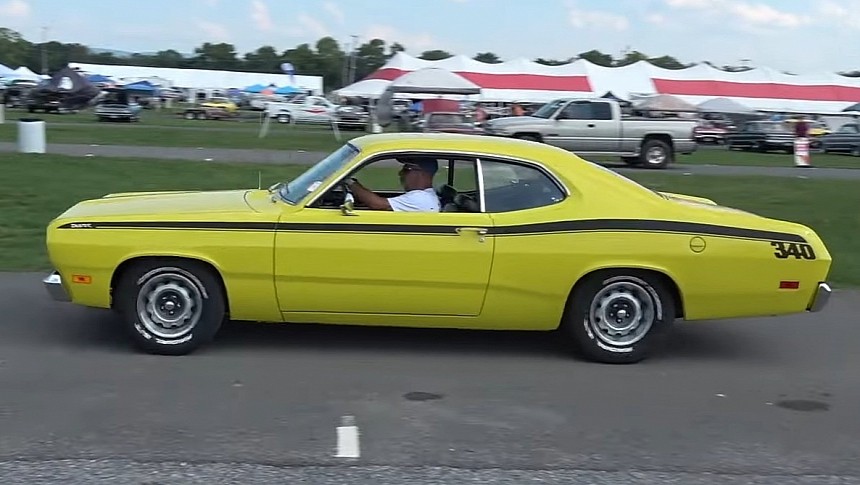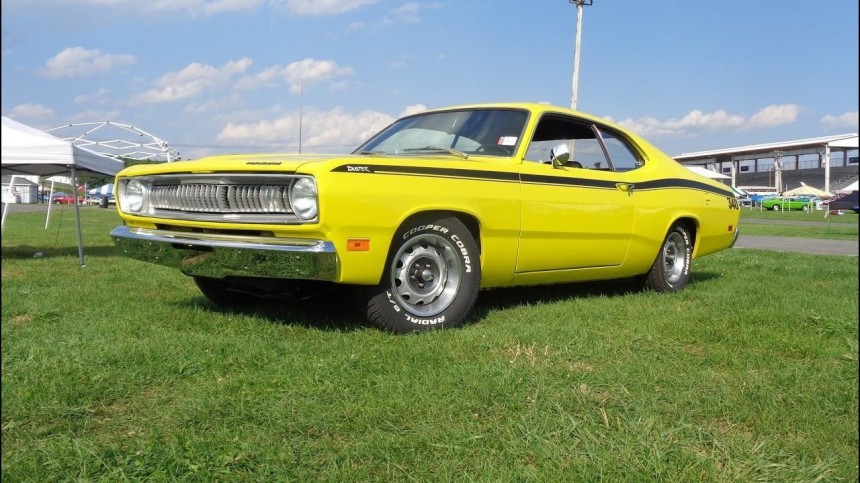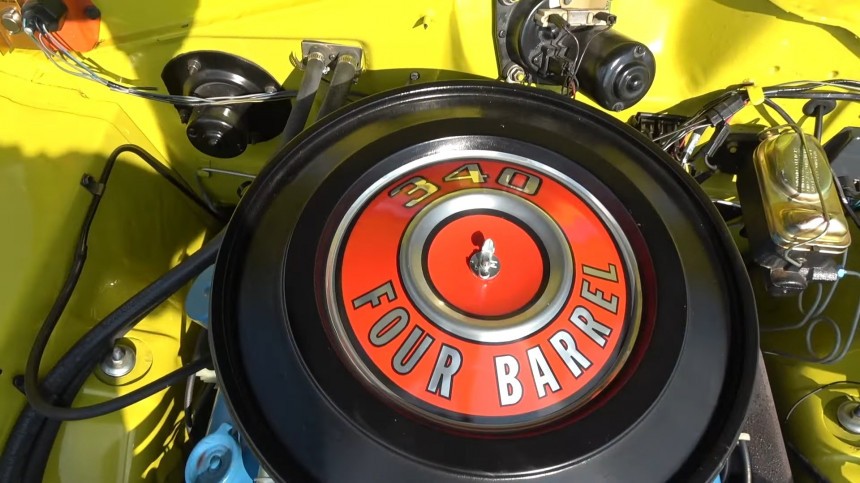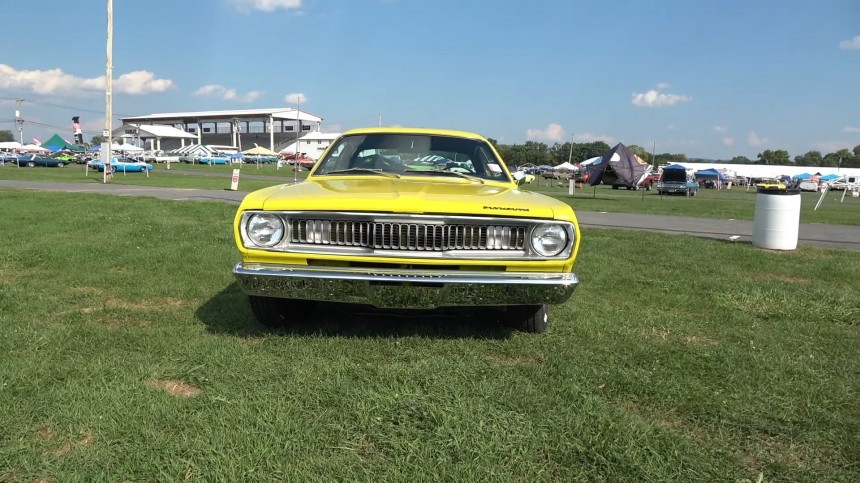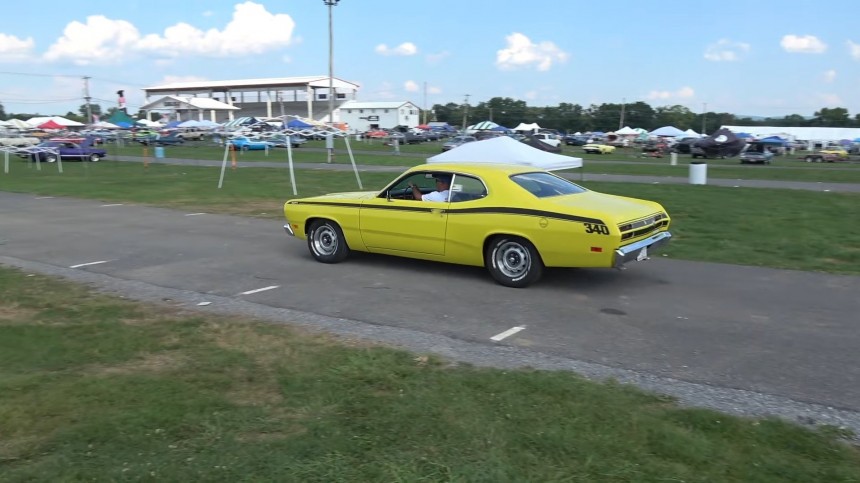For the 1970 model year, Chrysler made one of its best moves, transplanting the Barracuda and its newborn ‘twin cousin’ - the Challenger - to the newly created E-platform. However, the shift left the corporation with a void on the A-body slate vacated by the restyling of the Plymouth. A replacement was duly introduced – the Duster.
The oddly-named automobile was, basically, a two-door version of the Valiant with better styling than the Valiant Scamp. The Duster was a semi-fastback hardtop, and the Scamp was a regular two-door version of the Valiant sedan. (Chrysler had a peculiar way of organizing things).
The sleek looks weren’t new to the market – Chevrolet’s Nova popularized it in 1968: square front end, fluid rear-half, coke bottle hips, swept-back silhouette with a tape treatment over the end. Plymouth adopted the fashion, which worked; the Duster was an immediate sales success.
Critics will say it was the low price that attracted buyers. Rudely honest enemies of this automobile might go as far as paint this in the “dumb cars for dumb people” colors. Their argument was that Duster owners were more interested in the car’s ‘Point A to Point B’ ability than its gearheading attributes.
In a sense, the detractors of the Duster bring the Volkswagen Beetle argument to the table: the Plymouth was allegedly aimed at the same target segment of the market. Or, if this plea doesn’t convince, then perhaps the car’s notorious oxidation velocity can. Canadians used to affectionately call the new Mopar contraptions "Rusters," ironically pointing to the "biodegradability" of the bodywork.
The cure for the Plymouth’s hydrophobia was dirt-cheap, user-replaceable parts – an excellent incentive for its popularity, despite being as low-end as it came for a Detroit product. The resistor on the firewall’s left side was an infamous failure - it burned out, and the car would not start! Luckily, a two-bucks spare was always available – cautious drivers kept a box in the glove compartment.
In 1970, the Duster was introduced as a trim for the Valiant; from 1971 onward, the Plymouth was simply called “Duster.” It carried over, however, the appealing 340-cube V8 (5.6-liter) – probably the best feature offered by the small model. Not the go-to choice for the bulk of buyers: out of the 186,000 Dusters assembled for ’71, only 12,886 had the big engine.
Big for Duster Standards, of course: the other offers were a 318 two-barrel V8 (5.2 liters) or the 198-CID and 225-CID sixes (3.2 and 3.7 liters, respectively). The range-topping wedge 340 – introduced in 1968 – was an admirable machine that turned the compact automobile into a little Mopar pocket rocket.
One of the almost 13,000 Duster 340s built in ’71 is featured in the video attached to this article: a restored but correct Guinea pig with an unusual story. At one point in its life, it became a test car for a body repair shop. Technicians used to train their hands on this Duster, and the owner from that time slowly had it put together this way with the intention of selling it.
Ironically, the first offer came from the man who owned the space where the body shop operated, but the two friends failed to shake hands on a deal. Time moved on, but the Duster did not, and the two men got together one more time, and the car changed hands.
Although the Duster 340 was quite the sleeper – thanks to its low weight (2,830 lbs / 1,284 kg) and four-barrel muscle – this example, with its Curious yellow garment, is a head turner. In the 70s, the V8 was powerful enough to sweep many full-blown muscle cars off their big-block-backed wheels. Factory-rated at 275 hp (279 PS) and 340 lb-ft (461 Nm), it came with the standard three-speed automatic or two manual options (three- and four-speed).
Popular for its low price and reputed for durability, the 340 would take the underdog Duster over a standing quarter mile in low 14s. The four-speed was Chrysler’s A833 – one of the toughest four-on-the-floor in the business back then. After all, if a HEMI relied on it, a small-block was even more happy to oblige the asphalt tire-marking fun.
Because the Duster was born on a tight budget (15 million dollars in the late 60s), it didn’t have many bespoke parts. The bean counters from high up learned a painful lesson with the A-body Barracuda. The Fish Car was unique, bumper to bumper – except the cowl – and that cost Chrysler a lot of money.
It didn’t sell nearly as well as expected – the Mustang stole the show, even though it came on the market two weeks later than the first-generation Barracuda (in April 1964.) When the Barracuda was moved to the E-body and the Duster was crammed in its place, the design limitations were pretty restrictive. It had to have the same overall lines as the Nova, but it also had to be made from available or interchangeable parts.
Criticized and appraised with equal enthusiasm and fervor, the Plymouth Duster 340 was a pleasant surprise to drive, a nag to own, and a good deal for Chrysler. The corporation sold almost 1.32 million Dusters between 1970 and 1976 (but only 69,000 of those came with the 340). The overpunching V8 was dropped at the end of 1973, and the Duster was blown away by the winds of change three years later.
The sleek looks weren’t new to the market – Chevrolet’s Nova popularized it in 1968: square front end, fluid rear-half, coke bottle hips, swept-back silhouette with a tape treatment over the end. Plymouth adopted the fashion, which worked; the Duster was an immediate sales success.
Critics will say it was the low price that attracted buyers. Rudely honest enemies of this automobile might go as far as paint this in the “dumb cars for dumb people” colors. Their argument was that Duster owners were more interested in the car’s ‘Point A to Point B’ ability than its gearheading attributes.
The cure for the Plymouth’s hydrophobia was dirt-cheap, user-replaceable parts – an excellent incentive for its popularity, despite being as low-end as it came for a Detroit product. The resistor on the firewall’s left side was an infamous failure - it burned out, and the car would not start! Luckily, a two-bucks spare was always available – cautious drivers kept a box in the glove compartment.
In 1970, the Duster was introduced as a trim for the Valiant; from 1971 onward, the Plymouth was simply called “Duster.” It carried over, however, the appealing 340-cube V8 (5.6-liter) – probably the best feature offered by the small model. Not the go-to choice for the bulk of buyers: out of the 186,000 Dusters assembled for ’71, only 12,886 had the big engine.
One of the almost 13,000 Duster 340s built in ’71 is featured in the video attached to this article: a restored but correct Guinea pig with an unusual story. At one point in its life, it became a test car for a body repair shop. Technicians used to train their hands on this Duster, and the owner from that time slowly had it put together this way with the intention of selling it.
Ironically, the first offer came from the man who owned the space where the body shop operated, but the two friends failed to shake hands on a deal. Time moved on, but the Duster did not, and the two men got together one more time, and the car changed hands.
Popular for its low price and reputed for durability, the 340 would take the underdog Duster over a standing quarter mile in low 14s. The four-speed was Chrysler’s A833 – one of the toughest four-on-the-floor in the business back then. After all, if a HEMI relied on it, a small-block was even more happy to oblige the asphalt tire-marking fun.
Because the Duster was born on a tight budget (15 million dollars in the late 60s), it didn’t have many bespoke parts. The bean counters from high up learned a painful lesson with the A-body Barracuda. The Fish Car was unique, bumper to bumper – except the cowl – and that cost Chrysler a lot of money.
Criticized and appraised with equal enthusiasm and fervor, the Plymouth Duster 340 was a pleasant surprise to drive, a nag to own, and a good deal for Chrysler. The corporation sold almost 1.32 million Dusters between 1970 and 1976 (but only 69,000 of those came with the 340). The overpunching V8 was dropped at the end of 1973, and the Duster was blown away by the winds of change three years later.
